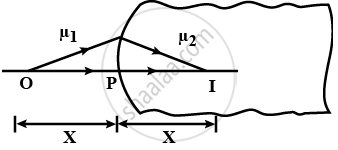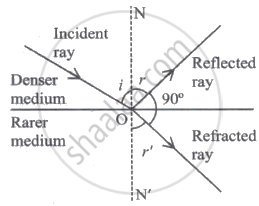Advertisements
Advertisements
प्रश्न
A slide projector has to project a 35 mm slide (35 mm × 23 mm) on a 2 m × 2 m screen at a distance of 10 m from the lens. What should be the focal length of the lens in the projector?
उत्तर
Given,
We are projecting a slide of 35 mm \[\times\] 23 mm on a 2 m
`xx` 2 m screen using projector.
Therefore, the magnification required by the projector is: `m= v/u`
here,
v = Image distance
u = Object distance
We will take 35 mm as the object size
∵ 35 mm > 23 mm
\[\therefore m = \frac{v}{u} = \frac{h_i}{h_o} \]
\[\frac{v}{u} = \frac{2 \times {10}^3}{35}\]
\[ \Rightarrow u = \frac{35}{2 \times {10}^3} \times v\]
\[ \Rightarrow u = \frac{35}{2 \times {10}^3} \times 10\]
\[ \Rightarrow u = 0 . 175 \text{ mm }\]
The lens formula is given by
\[\frac{1}{v} - \frac{1}{u} = \frac{1}{f}\]
\[\Rightarrow \frac{1}{10} + \frac{1}{0 . 175} = \frac{1}{f}\]
\[\Rightarrow \frac{10175}{1750} = \frac{1}{f}\]
\[\Rightarrow f = \frac{1750}{10175}\]
\[ f = 0 . 172 \text{ mm }\]
Hence, the required focal length is 0.172 mm.
APPEARS IN
संबंधित प्रश्न
What type of wavefront will emerge from a (i) point source, and (ii) distance light source?
The equation of refraction at a spherical surface is \[\frac{\mu_2}{\nu} - \frac{\mu_1}{\mu} = \frac{\mu_2 - \mu_1}{R}\]
Taking \[R = \infty\] show that this equation leads to the equation
\[\frac{\text{ Real depth }}{\text{ Apparent depth }} = \frac{\mu_2}{\mu_1}\]
for refraction at a plane surface.
A point source of light is placed at a distance of 2 f from a converging lens of focal length f. The intensity on the other side of the lens is maximum at a distance
A convex lens has a focal length of 10 cm. Find the location and nature of the image if a point object is placed on the principal axis at a distance of (a) 9.8 cm, (b) 10.2 cm from the lens.
A converging lens of focal length 15 cm and a converging mirror of focal length 10 cm are placed 50 cm apart with common principal axis. A point source is placed in between the lens and the mirror at a distance of 40 cm from the lens. Find the locations of the two images formed.
A converging lens of focal length 15 cm and a converging mirror of focal length 10 cm are placed 50 cm apart. If a pin of length 2.0 cm is placed 30 cm from the lens farther away from the mirror, where will the final image form and what will be the size of the final image?
A 5 mm high pin is placed at a distance of 15 cm from a convex lens of focal length 10 cm. A second lens of focal length 5 cm is placed 40 cm from the first lens and 55 cm from the pin. Find (a) the position of the final image, (b) its nature and (c) its size.
A point object is placed at a distance of 15 cm from a convex lens. The image is formed on the other side at a distance of 30 cm from the lens. When a concave lens is placed in contact with the convex lens, the image shifts away further by 30 cm. Calculate the focal lengths of the two lenses.
A ball is kept at a height h above the surface of a heavy transparent sphere made of a material of refractive index μ. The radius of the sphere is R. At t = 0, the ball is dropped to fall normally on the sphere. Find the speed of the image formed as a function of time for \[t < \sqrt{\frac{2h}{g}}\] . Consider only the image by a single refraction.
Use the above relation to obtain the condition on the position of the object and the radius of curvature in terms of n1and n2 when the real image is formed.
A spherical surface of radius R separates two medium of refractive indices µ1 and µ2, as shown in figure. Where should an object be placed in the medium 1 so that a real image is formed in medium 2 at the same distance?

A ray of light from a denser medium strikes a rarer medium at an angle of incidence i as shown in the figure. Refracted and reflected rays make an angle of 90° with each other. The angle of reflection and refraction are r and r'. The critical angle is ______.

Define the critical angle for a given pair of media and total internal reflection. Obtain the relation between the critical angle and refractive index of the medium.
A point object in the air is placed symmetrically at a distance of 60 cm in front of a concave spherical surface with a refractive index of 1.5. If the radius of curvature of the surface is 20 cm, find the position of the image formed.
Obtain an expression for refraction at a single convex spherical surface, i.e., the relation between μ1 (rarer medium), μ2 (denser medium), object distance u, image distance v and the radius of curvature R.
